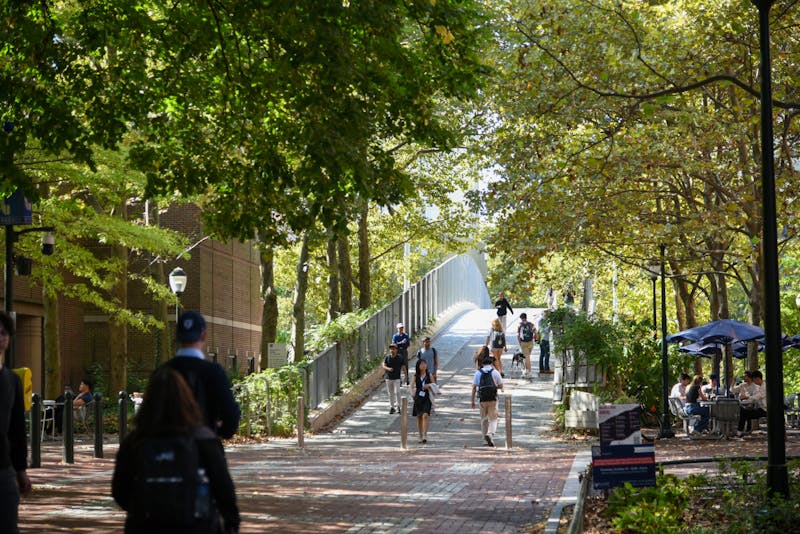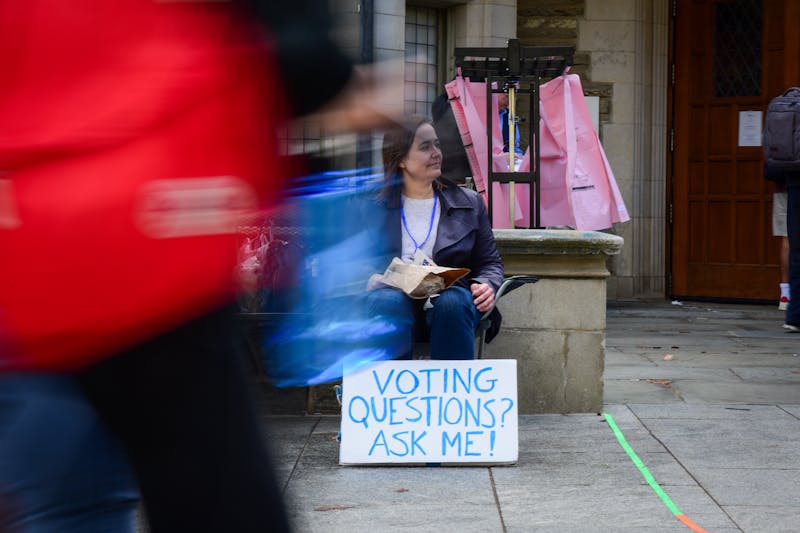Our approach will be a collaborative effort among parents, teachers, children and the community in order to achieve the fullest potential of our students." - excerpt from the Alexander Wilson mission statement. Martha Hodges-Gritter, a small woman who blends into her classroom's pre-adolescent population, could easily be mistaken for one of her fifth-grade students. Until she turns around, that is, and shows the class who's boss. "I am tired of this noise!" she tells the class, which sounds more like a circus. With 26 elementary school kids to teach -- and control -- for more than six hours per day, she has every right to be exhausted. But when University student volunteers give up valuable time to assist Gritter in her daily grind, she is more than thrilled to welcome "another body in the classroom." These students, part of Linguistics Professor Bill Labov's Linguistics 160: African-American Linguistics course, aim to be unofficial teacher's aides while studying the social and linguistic environment of West Philadelphia's Alexander Wilson Elementary School. As one of the most recent additions to the ever-expanding list of academically based community service courses at the University, Labov's class examines the controversial topics surrounding the "ebonics" debate. While the hubub of last spring's Presidents' Summit on Volunteerism has died down, the Center for Community Partnerships has been pivotal in working to fulfill University President Judith Rodin's goal of doubling the number of courses that include a community service component. The current number of courses is around 50. These courses run the disciplinary gamut from Anthropology to Theater Arts, with the obvious concentrations in Social Work, Education and Urban Studies. Labov's course, which made its debut in the Philadelphia Public School System early this month, focuses on the controversial relationships between children's "every-day language" and their reading performance in school. To show that learning can be fun, Labov's class hopes to have the elementary school children keep journals defining in standard English the "slang" words that are common to the kids, most of whom are black. "We want to reduce the distance between teachers and kids," said Labov, stressing the importance of motivating the kids "without abandoning their allegiance to the cultural values that are most important in the African-American community." College senior Raymond Hunt, who also works in Gritter's fifth-grade class, called the children "a source of creative energy" and explained his role in the classroom. "I'm like the new kid in class," he said. "I just enjoy being there to see them as they make advances toward their future." College senior Ali Caccavella, like Hunt, has spent these past weeks not necessarily studying the linguistic patterns of the Wilson students, but simply establishing a base of trust in the classroom. "At first, I didn't concern myself with the dictionary," she admitted. "Right now, I'm helping the teacher out." Caccavella has worked in the Philadelphia Public School System on several different occasions and is currently working on an Urban Studies thesis examining partnerships between the University and local schools. Students in community-focused courses like Labov's class have to complete a "goal" or project by the end of the semester. But the interaction between the college and K-12 students is designed to be mutually beneficial, assisting the troubled schools while fostering environments rich for University research. Labov's class uses popular music, clothing and language to engage the children in conversation -- conversations that in turn can be used as data for research on dialects and their potential as bridges to learning Standard English. Examining the larger problem of motivating kids to learn to read and stay in school, Caccavella noted the lack of role models in the children's lives -- a dearth that Penn volunteers hope to remedy with their presence. "I think that more people from Penn should participate and use those skills that got them to Penn," Hunt said. Labov, realistically skeptical about the effects his class' project can have, noted that the "reading problem has been especially resistant." "We can never be sure that any effort to contribute to education will succeed," he said. "Our current research is designed to give the teachers the tools to reduce [cultural conflict in the classroom]." When looking at community service components of University courses, CCP operates as a key liaison between Penn and the Philadelphia system. Bettina Baker, a doctoral student in the Graduate School of Education, helped to coordinate the Labov project with CCP's connections in the West Philadelphia community. "Many teachers are floundering," she said. "The idea is to establish regular, continued contact with the schools, having the programs become institutionalized partnerships." Wilson Principal Arthur Hall also recognized the usefulness of Penn's presence in the West Philadelphia classrooms. "It reduces the student-adult ratio in the classroom," he said. As foundational relationships are being formed between the Penn and Wilson students collaborating on Labov's project, Hall noted his support for the dictionary's premise as a new and innovative way to look at the connection between education and language. "You couldn't expect urban kids to speak the same as suburban kids," he said. "The culture is different. They need to understand that." And fifth-grader Dominique Little said, "We should have more than one teacher in the classroom, some people really need help?. [The Penn students] help us to read and sound out words." Other area schools have also reaped the benefits of newly implemented academically based community service collaborations. Environmental Studies Professor John Keene and his class, for example, study "brownfields" -- or abandoned industrial sites that contribute to low property values and pollution in cities like Philadelphia. Working with University City High School students, Keene's Environmental Studies 404 course is developing projects that will identify and map the brownfield sites around their neighborhoods. Later this semester, students from both institutions will study the history and environmental risks of these sites and brainstorm options for remediation. "It's a fascinating experiment," Keene said of the course, which premiered this fall. "I hope the high school kids get a kick out of this." College senior Christina Wolf emphasized the "experimental" nature of the new collaboration. After all, Keene's class is in the beginning stages of developing group projects and getting UCHS students to critically examine their surroundings. "Our involvement will not be easy to define until the semester's over, and we have seen what we've been able to accomplish," Wolf said. "But we can't beat ourselves up if we don't finish by the end of the semester." Like Labov's class, Keene's students have been spending much of the semester helping teachers give students more individual attention, forming bonds of trust that pave the way for additional cooperative programs in the future. "I just hope I can teach them some of the things I've learned [in college]," Wolf added. Keene's group works with UCHS environmental science teacher Beverly Green. Just as Keene's students are enthusiastic but apprehensive about the new collaboration's outcome, Green's students are anxious about the prospects of working with Penn students. "Some are shy, since we've never done anything like this before," said Green of her students. "Some have told me that they're confused, and I tell them, 'Me too'." But while the process of establishing such collaborative projects is daunting for both parties, Green called the partnership a "good match" and pointed to the importance of Penn students as role models in her class. Although many of her students had mixed thoughts at the beginning of the year on attending college, Green says now, "They look at the Penn students and think, 'Hey, if they can go to college, so can I'!" Ira Harkavy, vice president and director of CCP, praised the University's community service courses as a way to reduce the community concern that Penn is indifferent to issues facing local schools. "We are mutual partners, trying to solve real-world problems," he said. While Keene's and Labov's courses could be described as pilot projects between Penn and West Philadelphia schools, many other classes are time-tested examples of academic bridges to the community. English Professor Peter Conn's "Teaching American Studies" class, currently in its third year, is modeled on a graduate course taught for the past 18 years. In the course, Conn's students examine Philadelphia schools first-hand by cooperatively developing a joint curriculum for both the high school and Penn students. Conn teaches the course on set days at UCHS and other days at the University. Outside these set class times, University students go to UCHS to teach the high school students social studies.
The Daily Pennsylvanian is an independent, student-run newspaper. Please consider making a donation to support the coverage that shapes the University. Your generosity ensures a future of strong journalism at Penn.
DonatePlease note All comments are eligible for publication in The Daily Pennsylvanian.







